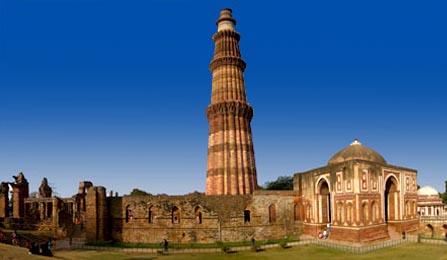Qutub Minar Delhi

Information on Qutub Minar (New Delhi) - History & Architecture
Qutub Minar is quite a prominent historical monument which is located at the capital city of India, Delhi. The Qutub Minar is a stone tower which is also referred as a minaret and stands 73 metres tall in height. The height of the minaret is considered to be an unique characteristic and therefore, it is known to be one of the tallest minarets in India. The minaret was learnt to be actually constructed so as to mark the victory of a Muslim ruler, Qutub I-Din Aibak after claiming the last ever Hindu empire in Delhi. However, the monument was finally completed by Illtutmish who was the successor of Qutub I-Din. The minaret is made of red and beige coloured sandstones.
Qutub Minar Delhi Architecture
Qutub Minar is fundamentally an Islamic Monument which was built in the year 1193 emblazoned with Arabic writings. The structure of the monument is said to be based on Afghan form of architecture. The monument includes five separate storeys or floors with a balcony extension for each along with attractive and delicate carvings. The balconies surround the minaret and are held up by brackets made of stones, which are further highlighted with a honey-comb kind of design. The tower is full with inscriptions in Nagari and Arabic all around it which provides an insight into the history of the monument and even divulges the fact that Illtutmish completed the construction of the tower. The initial three floors are constructed with red sandstone and the other two entail a combination of both sandstone as well as marble. The minar houses as many as 379 steps in an ascending order.
Qutub Minar Delhi History
The word Qutub denotes pillar of integrity and thus, symbolizes Islamic justice. The soaring pointed tower is learnt to be a wonderful illustration of Indo-Islamic architecture which was actually inspired by the victory towers made of brick in Afghanistan. Although, it has been previously mentioned in the article that the minaret was learnt to be constructed by Qutub I-Din but, according to the specifications of history books, the intial foundation of the minaret was laid by Prithviraj or even by his uncle named Vigraharaja.
The base floor of the tower is in fact a mosque prevalently known as the Quwwat-ul-Islam Mosque which is also considered to be the earliest mosque in India. An inscription on the eastern gate of the tower divulges the information that the minaret was erected with supplies which were acquired after destructing 27 Hindu shrines which is quite appalling and provoking. An iron post around 7 metres in height is situated in the patio and is believed that prayers are answered if it the post is encircled with ones hands in a standing position, keeping it at the back. There are supposed to be quite some arguments regarding the reason behind the erection of the monument. Few suppose that it was constructed as a victory tower in order to mark the commencement of Muslim rule in the country whereas others believe that it acted as a minaret for giving prayer calls by the muezzins.
Qutub Minar Delhi Tourism Significance
Qutub Minar is considered to be amongst the world heritage sites listed by UNESCO which vividly explain the historic significance of the minaret thus, making it one of the highly visited Indian monuments by around 3.9 million visitors each year. The minaret is a tower with a foundation width of 14.32 metres which decreases with the height which makes it approximately 2.75 metres in width on the crest providing it with an elevation of around 73 metres. The height of the minaret has been a major contributing factor towards positioning it amongst the popular and tallest towers around the globe. The complex of Qutub Minar houses the Iron Pillar which is regarded as one of the primary metallurgical interests globally and an iron marvel.
- Andaman Nicobar Monuments
- Andhra Pradesh Monuments
- Assam Monuments
- Bihar Monuments
- Chhattisgarh Monuments
- New Delhi Monuments
- Goa Monuments
- Gujarat Monuments
- Haryana Monuments
- Himachal Pradesh Monuments
- Jammu and Kashmir Monuments
- Karnataka Monuments
- Kerala Monuments
- Madhya Pradesh Monuments
- Maharashtra Monuments
- Odisha Monuments
- Punjab Monuments
- Rajasthan Monuments
- Tamil Nadu Monuments
- Telangana Monuments
- Uttar Pradesh Monuments
- West Bengal Monuments